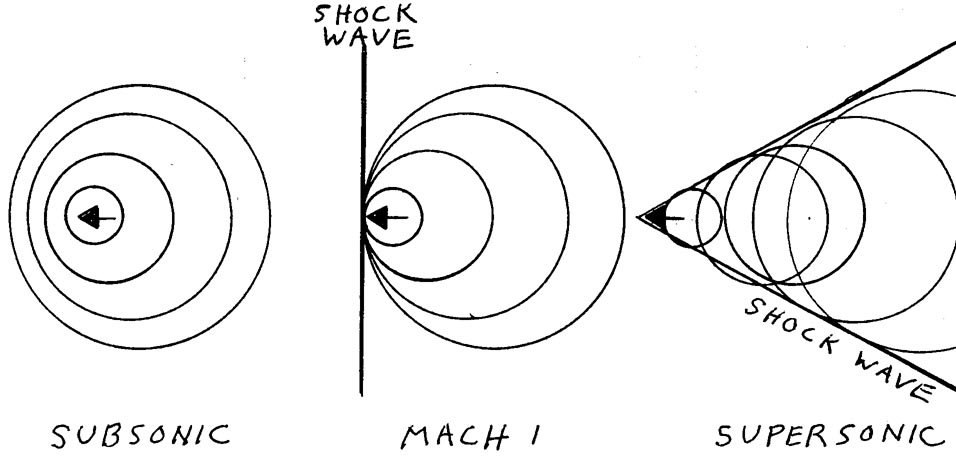
| MadSci Network: Physics |
Greetings:
As an aircraft, rocket, car or even ducks move through the air they cause pressure waves in the air that radiate out in all directions at the speed of sound. In the left illustration a vehicle (arrow) is moving to the left at subsonic speed and slightly catches up to the sound waves in front of it and leaves the trailing waves behind it. At the speed of sound (Mach 1) shown in the middle illustration, the vehicle is traveling fast enough to catch up with all of the forward radiating sound waves, forming a strong pressure wave normal to the vehicle. This is the pressure wave that destroyed many aircraft before the flight of the X-1 in 1947. If the vehicle has the proper design and has enough power to penetrate the shock wave by exceeding the speed of sound, it can out run the shock wave which then bends back to form a strong shock cone. When this cone reaches observers on the ground or at track side, the sudden change in pressure as the wave passes causes a sonic boom. Large vehicles such as the space shuttle and the Concord supersonic airliner have a second distinct shock cone that forms from the rear of the vehicle caused by the air back filling the void left behind the plane or car. When this happens we hear double sonic booms spaced about a second apart.

As the vehicle passes through Mach 1 the pilot or driver senses a sudden silence because they are outrunning all air noise. However, when they return to subsonic speed they experience great noise as the shock wave(s) catch up and pass the vehicle.
I have had the opportunity to experience many sonic booms at Edwards Air Force Base in California, including the landing space shuttles and many supersonic fighter aircraft. The greatest boom that I have ever experienced was when the giant XB-70 bomber went supersonic at 40 thousand feet above the air base. The double sonic booms were like fireworks going off next to your ears. The B-70 was designed to ride up on the shock cone to gain extra energy from the wave, just as a surfer rides up on a breaking water wave.
Surprisingly, ducks fly in V formations with the lead duck setting up pressure vortices in the air in a V shaped wave. The other ducks in the formation ride the V wave and use only one half of the energy to fly that the lead duck must use. The aerodynamics for low speed flight are very different than that of supersonic flight, but many of the concepts and mathmatical models are similar.
Best regards, your Mad Scientist
Adrian Popa
Try the links in the MadSci Library for more information on Physics.
MadSci Home | Information |
Search |
Random Knowledge Generator |
MadSci Archives |
Mad Library | MAD Labs |
MAD FAQs |
Ask a ? |
Join Us! |
Help Support MadSci
MadSci Network
© 1997, Washington University Medical School
webadmin@www.madsci.org